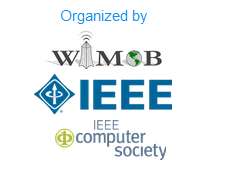| |
Call For
Papers 
Providing adapted e-health
services, applications and platforms responds to a growing need
of medical institutions like hospitals or even homes. Patients
with long-term conditions, elderly and dependent persons need
to receive e-health services and assistance in a simple, continuous
and non intrusive way. When the e-health ecosystem meets the needs
of targeted people and gains their acceptance, provided services
will help to tackle the problems that face the nowadays world’s
population such as dependency, aging and healthcare for all. According
to the United Nations projections, in 2050, the old-age dependency
ratio of the population aged over 65 years will approximate 51,70%
of the rest of the population. This situation points out the issue
of developing autonomic healthcare systems and platforms that
helps people to manage their own health with new services and
better adapt institutionally based services.
The international IEEE workshop
of e-Health Pervasive Wireless Applications and Services e-HPWAS'15 (in conjunction with the 11h IEEE WiMob conference)
targets providing optimal, secured and context aware e-health
services with the best quality of services (QoS) and user’s
experience (QoE). Applications and services are considered in
wireless environments and architecture with a strong heterogeneity
of the used access technologies, sensors, terminals, users’
needs and services (data, content, live streams or complex network
services). Emerging e-Health services and applications can involve
the use of “heavy” content such as multimedia content
and streams (e.g. 3D-TV, media conferencing, remote live diagnostics)
using conventional e-health equipments and devices but also using
modern devices like smart TV sets, home-boxes, smartphones and
tablets. The considered issues of e-HPWAS are related to e-Health
care and safety services provided for patients, elderly and dependent
persons. These services are generally built using different communication
technologies, for different profiles of people and in different
contexts and places (e.g. in health institutions, at home, in
the city). Ideally, provided services should be accessible anytime,
anywhere and using any kind of device or platform.
Different norms can be used
within the e-health ecosystem hence the network interoperability
has to be considered carefully in the design of context aware
applications and services. Heterogeneity is present at different
levels and still an open issue in e-health systems. In addition
to the heterogeneity of patients' profiles and service characteristics,
the health environment involves a wide range of required sensors
and actuators (e.g. blood pressure and temperature, insulin delivery,
appliance control, presence sensors) that can be sometimes very
close to the user such in Body Area Networks. Sensors use usually
different wireless access methods, need to work together and communicate
with the rest of the infrastructure (if it exists): gateways,
servers, local smart objects or with the intelligence existed
in the medical institution, home or in the cloud. Faced to the
strong heterogeneity of the environment where e-health services
are provided, mechanisms of making autonomic decisions (e.g. diagnostics,
continuous monitoring, alerts, assistance) have to be identified
and studied in different levels. For a given service or application,
the automatic identification of required sensors and actuators
should be ensured and tailored to the context of the person (e.g.
health status, mobility, dependency degree) and the characteristics/constraints
of the used communication technology and the platform.
Other opened issues concern
the deployment and placement of sensors in the communication architecture.
Services deployment should be optimized to guarantee the best
network coverage, coordination between sensors and middleware
or gateways, possible attachment to the network infrastructure
and delay tolerant networking aspects. The cohabitation of different
access methods and communication technologies of sensors and the
other devices involves sensor/device discovery, network attachment
and exploitation of the function that a sensor could provide.
The heterogeneity of the communication technologies used within
the same e-health system may affect negatively the performance
of the architecture and result on a non optimized network traffic
even only in the discovery phase of existing sensors and services.
Dealing with the existing heterogeneity should lead to optimal
approaches that identify available sensors and devices, available
functions provided by the hardware, available services and their
possible composition to match a given context, normalized interfaces
required to interact with the different actors in the e-health
context aware ecosystem.
eHPWAS encourages the
submission of original works describing
research results, practical or industrial e-health solutions.
Papers describing advanced prototypes, platforms, techniques and
general survey for discussing future perspectives and directions
are also encouraged. Topics include but are not limited to:
|
|
E-Health services
in smart environments (smart homes, smart medical institutions,
smart cities)
|
|
|
User acceptance
of advanced and complex e-health services
|
|
|
Sensor networks
for e-Health services
|
|
|
Quality of Experience
(QoE) with e-health applications, services and network
technologies
|
|
|
E-Health services
composition and adaptation
|
|
|
Wireless sensors,
mobiles and cognitive radio networks
|
|
|
Network interoperability
in the e-health ecosystems
|
|
|
Delay tolerant networking
(DTN) with e-health services development
|
|
|
Existing and ongoing
Web norms and technologies for e-Health
|
|
|
Context Models for
people monitoring and Activities of Daily Living (ADL)
|
|
|
Heterogeneity of
e-Health environments and platforms (used sensors and
actuators, heterogeneous access technologies, medical
places)
|
|
|
Techniques and models
for performance evaluation, simulation, and optimization
|
|
|
Wireless networking
security and privacy (e.g. access networks, exchanged
and shared medical data)
|
All accepted papers will be published in the 11h IEEE WiMob conference
proceedings published by IEEE, and will be accessible via IEEE Xplore Digital Library and indexed by DBLP. The workshops will be held on October 19, 2015.
All papers will be considered for the Best Paper Award.
The workshop organizers will select a number of candidates for
the award among accepted papers.
The e-HPWAS organizers plan to have selected
papers appear in a special journal issue. A selection
of accepted papers will be considered and authors will be invited to produce an extended version to be published in a special
issue of the International
Journal of E-Health and Medical Communications (IJEHMC).
PAPER SUBMISSION DUE: July 18, 2015 (firm)
For any enquiries, please contact: Tayeb.Lemlouma[at]irisa.fr
|
|



